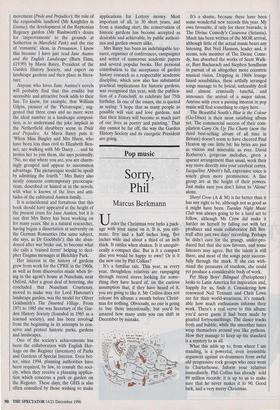Gardens
Novel designs
Ursula Buchan
When Mr Darcy dived into the lake at Pemberley, in the BBC series Pride and Prejudice last year, the nation (or that half of it which is female at least) gasped. But was it the sight of Cohn Firth's chest or was it disbelief that there could be an ornamen- tal lake at Pemberley? After all, as every Janeite knows, Pemberley was not a Brow- nian 'landscape'. Mr Darcy owned a trout stream, which he offered to put at the dis- posal of Mr Gardiner, but no lake.
This may not have mattered to every last viewer, but it would surely have mattered to Jane Austen, whose novels are shot through with references to contemporary attitudes on gardens and their making, on landscape, nature and much else. Indeed, each novel characterises, and often satiris- es, some development in thought or fash- ion in Georgian England: for example, the gothic imagination in Northanger Abbey; the way the landscape and nature were viewed by devotees of the 'Picturesque' movement (Pride and Prejudice); the role of the responsible landlord (Mr Knightley in Emma); the development of the Reptonian Regency garden (Mr Rushworth's desire for 'improvements' to the grounds at Sotherton in Mansfield Park) and the rise of 'romantic' ideas, in Persuasion. I know this because I have just read Jane Austen and the English Landscape (Barn Elms, £19.99) by Mavis Batey, President of the Garden History Society, and expert on landscape gardens and their place in litera- ture.
Anyone who loves Jane Austen's novels will probably find that this erudite but accessible and attractive book adds to their fun. To know, for example, that William Gilpin, pioneer of the 'Picturesque', sug- gested that three cows and no more were the ideal number in a landscape composi- tion, is to understand the joke implicit in the Netherfield shrubbery scene in Pride and Prejudice. As Mavis Batey puts it: 'When Miss Bingley and Mrs Hurst, who have been less than civil to Elizabeth Ben- net, are walking with Mr Darcy. .. and he invites her to join them, she says pointedly, "No, no stay where you are, you are charm- ingly grouped and appear to uncommon advantage. The picturesque would be spoilt by admitting the fourth." ' Mrs Batey also neatly connects contemporary preoccupa- tions, described or hinted at in the novels, with what is known of the lives and atti- tudes of the cultivated Austen family.
It is coincidental and fortuitous that this book should have appeared at the height of the present craze for Jane Austen, but it is one that Mrs Batey has been working on for many years. She is a natural researcher, having begun a dissertation at university on the German Romantics (the same subject, she says, as Dr Goebbels'); this she aban- doned after war broke out, to become what she calls a 'trained ferret' helping to deci- pher Enigma messages at Bletchley Park.
Her interest in the history of gardens grew from work for the CPRE in the 1960s, as well as from discoveries made when liv- ing in the agent's house at Nuneham, near Oxford. After a great deal of ferreting, she concluded that Nuneham Courtenay, moved to make way for Lord Harcourt's landscape garden, was the model for Oliver Goldsmith's The Deserted Village. From 1971 to 1985 she was Secretary of the Gar- den History Society (founded in 1965 as a learned society), and has been involveil from the beginning in its attempts to con- serve and protect historic parks, gardens and landscapes.
One of the society's achievements has been the collaboration with English Her- itage on the Register (inventory) of Parks and Gardens of Special Interest. Even bet- ter, since 1994, planning authorities have been required, by law, to consult the soci- ety, when they receive a planning applica- tion which concerns a park or garden on the Register. These days, the GHS is also often consulted by those wishing to make applications for Lottery money. Most important of all, in 30 short years, and from a standing start, the conservation of historic gardens has become accepted as desirable and achievable, by public authori- ties and garden owners alike.
Mrs Batey has been an indefatigable lec- turer, organiser of conferences, campaigner and writer of numerous academic papers and several popular books. Her personal contribution to the acceptance of garden history research as a respectable academic discipline, which now also has substantial practical implications for historic gardens, was recognised this year, with the publica- tion of a Festschrift, to celebrate her 75th birthday. In one of the essays, she is quoted as saying: 'I hope that as many people as possible will visit and love gardens, and that their history will become as much part of our lives as poetry and painting.' That day cannot be far off, the way the Garden History Society and its energetic President are going.



















































































































 Previous page
Previous page